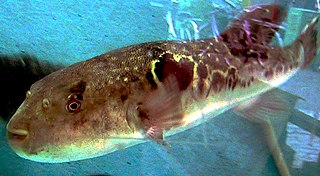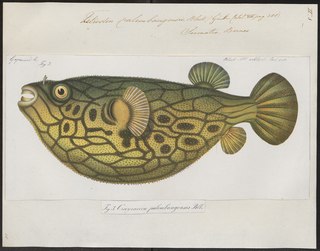
Tetraodontidae is a family of primarily marine and estuarine fish of the order Tetraodontiformes. The family includes many familiar species variously called pufferfish, puffers, balloonfish, blowfish, blowers, blowies, bubblefish, globefish, swellfish, toadfish, toadies, toadle, honey toads, sugar toads, and sea squab. They are morphologically similar to the closely related porcupinefish, which have large external spines.

Takifugu, also known by the Japanese name fugu, is a genus of pufferfish with 25 species, most of which are native to salt and brackish waters of the northwest Pacific, but a few species are found in freshwater in Asia or more widely in the Indo-Pacific region. Their diet consists mostly of algae, molluscs, invertebrates and sometimes crustaceans.

Tetraodon is a genus in the pufferfish family (Tetraodontidae) found in freshwater in Africa. It is the type genus of the family and historically included numerous other species; several Asian species were moved to the genera Dichotomyctere, Leiodon and Pao in 2013.

The Mbu pufferfish, also known as Mbuna pufferfish, giant pufferfish, or giant freshwater pufferfish, is a carnivorous freshwater pufferfish originating from the middle and lower sections of the Congo River in Africa, as well as the east coast of Lake Tanganyika near the Malagarasi River mouth.

The fahaka pufferfish, also known as the Nile puffer, globe fish, lineatus puffer, is a tropical freshwater pufferfish found in the upper Nile, Chad, Senegal, Gambia, Geba, Volta and Turkana basins in West, Northeast and East Africa.

The Congo puffer or potato puffer is a freshwater pufferfish found in areas of the Congo River in Africa, including rapids.

Carinotetraodon is a polyphyletic genus of small freshwater pufferfish found in South and Southeast Asia. Several species have commercial importance as aquarium fish.

Dichotomyctere ocellatus, commonly the figure 8 puffer or eyespot puffer, is a pufferfish found in freshwater in Southeast Asia. It is known from the lower reaches of the Mekong (Cambodia), the Peninsular Malaysia as well as Borneo.

Valentin's sharpnose puffer, also known as the saddled puffer or black saddled toby, is a demersal marine fish belonging to the family Tetraodontidae. The saddled puffer is a small sized fish which grows up to 11 cm. It is widely distributed throughout the tropical and subtropical waters of the Indian Ocean, Red Sea included, and until the oceanic islands of the Pacific Ocean. It inhabits rocky and coral reefs, lagoons and external reef until 55 m. Canthigaster valentini has a diurnal activity.

Colomesus asellus, the Amazon puffer, asellus puffer, South American freshwater puffer, Peruvian puffer, or Brazilian puffer is a species of pufferfish confined to the Amazon, Essequibo and Orinoco basins in tropical South America. It is a popular aquarium species.

Carinotetraodon irrubesco, known commonly as the red-tail dwarf puffer, is a freshwater pufferfish found only in the lower Banyuasin basin in South Sumatra and the Sambas River in West Kalimantan.

The grass puffer, or Kusa-fugu, is a species of fish in the pufferfish family (Tetraodontidae). This common to abundant species is found in the northwest Pacific Ocean in China, Japan, Korea, the Philippines and Vietnam. It is primarily found in coastal waters, ranging to depths of 20 m (66 ft), but is often seen in brackish water and has also been recorded briefly entering freshwater. The grass puffer reaches up to 15 cm (6 in) in length.

Pao palembangensis, is a species of freshwater pufferfish native to Thailand, Laos, Malaysia and Indonesia in Southeast Asia. Its commonly called the humpback puffer or dragon puffer. It is bred for aquaria as an ornamental fish because of its beautiful skin colouration and pattern.

Canthigaster rostrata, commonly known as the Caribbean sharp-nose puffer, is a pufferfish from the Western Central Atlantic. The Caribbean sharp-nose puffer is a small fish with a maximum length of 12 cm or approximately 4.7 inches. It can be encountered from the coast of South Carolina to Venezuela, including Bermuda, the Gulf of Mexico, and in the Caribbean Sea. They can live up to 10 years in the wild, females typically live longer due to aggressive male territory behavior. The Caribbean sharp-nose puffer is a highly toxic species of marine fish due to the presence of tetrodotoxin in its tissues and organs. Despite its toxicity, the sharp-nose pufferfish occasionally makes its way into the aquarium trade.

Kallar is the upper tributary of Vamanapuram River flowing through the Indian state of Kerala. The river originates in the Chemunjimotta hills hills on the southern side of the Western Ghats, and flows entirely through Thiruvananthapuram district of Kerala. The Meenmutty Falls and Lower Meenmutty dam are situated in this river.
Carinotetraodon imitator, commonly known as the dwarf Malabar pufferfish, is a freshwater pufferfish found in the Western Ghats of India, with little information available on its complete distribution. It is one of the smallest pufferfish in the world, and closely resembles the related Carinotetraodon travancoricus.
Somphong's puffer, redeye puffer or crested puffer is a small freshwater blowfish found in mainlands Southeast Asia such as Thailand, Cambodia, Vietnam. This fish has been collected in the past for the aquarium trade.

Carinotetraodonborneensis, sometimes known as the Bornean red-eye puffer, is a species of pufferfish in the family Tetraodontidae. It is a tropical freshwater species known only from southern Sarawak, Malaysia. It reaches 4.4 cm SL and is sometimes seen in the aquarium trade.
Carinotetraodon salivator, also known as the striped red-eye puffer, is a species of freshwater pufferfish in the family Tetraodontidae. It is a tropical species known only from Sarawak, Malaysian Borneo, where it occurs at a depth range of 1 to 2 m. It is found in large, fast-flowing streams with silty and sandy bottoms, leaf litter, and submerged logs. It reaches 4 cm (1.6 in) standard length and is occasionally seen in the aquarium trade.

Takifugu chrysops is a species of pufferfish in the family Tetraodontidae. It is a marine species known from Japan, where it ranges from Tosa Bay to Tokyo Bay. It is a demersal fish that reaches 20 cm SL. Although sometimes known as the red-eyed puffer, this can lead to confusion with several freshwater species of the genus Carinotetraodon.





















